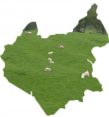‘A village and parish in Market Bosworth district Leicester. Acres, 2400. Real property, £4416. Population, 708. The church is a neat building. There are a Baptist chapel, an endowed school with £20 a year, and charities £20.’ J.M. Wilson, Imperial Gazetteer of England and Wales (1870-72)
Free school
In 1720, money bequeathed under the will of Lord Crewe (a former Bishop of Durham) purchased a building for a Free School at a cost of £30. His charities also provided £20 per annum for a master.
Daily schools for poorer families in 1818 (population 410 in 1811)
There was only Lord Crewe’s school, which 30 children attended.
Daily schools in 1833 (population 590 in 1831)
Lord Crewe’s school now contained 60 children of both sexes. The master received £20 annually and had the use of a small house and garden. There were also two infants’ schools, in which 40 children of both sexes are instructed at the expense of their parents.
Daily schools connected to the Anglican Church in 1846-7
By 1847, nearly all the older boys in the parish attended Lady Noel Byron’s school in the neighbouring parish of Kirkby Mallory. Younger children of both sexes attended a dame’s school.
Schools after 1851
Other records suggest that although the school had been enlarged in 1843, at a cost of £70 funded jointly by the trustees and the rector, the income from the endowment was insufficient to attract a schoolmaster, and the school closed. By 1872, the charity was in Chancery, and awaiting decisions by the trustees and the Endowed Schools Commisioners as to its future.
National School
A new mixed school and schoolhouse were built in 1876 costing £1500. The school was further extended in 1884 to accommodate 170 children.
Council School

By the early 20th century the Church School was too small, but the school managers were not in favour of extending it, perhaps because they could not fund this. Although the Church School remained in use, a Council School was built in 1910 to supply the additional places. It could accommodate 140 children. The arrangement was that all village infants would attend the Council School and all older children would attend the Church School.
From 1930 this arrangement changed, perhaps because the Church School could not meet new building regulations. The Council School was enlarged to take all children under 11 years, the Church School closed on week days (although it continued to be available for a Sunday school) and older children went to school in Ibstock.
The Council School has been enlarged many times during the 20th century, and the building is the present day County Primary School.
Read more about the history of schools in Newbold Verdon.
Sunday schools
In 1818
No Sunday school is mentioned.
In 1833
There was a Sunday school, attended by 60 children, including most of those who attended the daily school. Both sexes were instructed gratuitously. Although no denomination was given, it was probably Anglican.
Anglican Sunday school in 1846-7
Almost all the older boys were said to attend the parish Sunday school. No comment was made about the girls, or younger children.
In 1851 (population 712)
On 30 March 1851, 120 people attended both the morning and afternoon Sunday School classes provided by the Anglican church. There were Baptist and Primitive Methodist chapels in the village, but neither held a Sunday school on that day.
Return to A History of Leicestershire Schools: A-Z
Sources
- Education of the Poor Digest, Parl. Papers 1819 (224)
- Education Enquiry, Parl. Papers 1835 (62)
- National Society for Promoting the Education of the Poor in the Principles of the Established Church, Result of the Returns to the General Inquiry made by the National Society, into the state and progress of schools for the education of the poor … during the years 1846-7, throughout England and Wales ( London, 1849).
- 1851 Ecclesiastical census
- Lambeth Palace Library, National School File, Newbold Verdon (uncatalogued)
